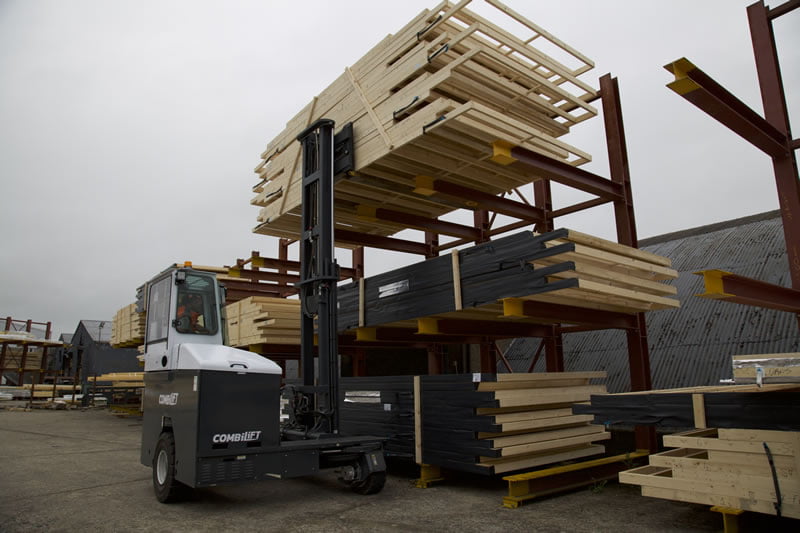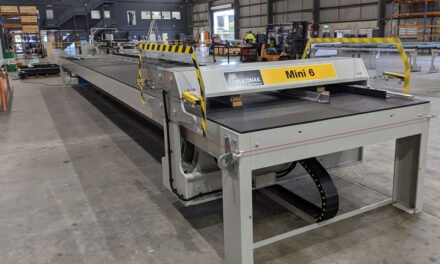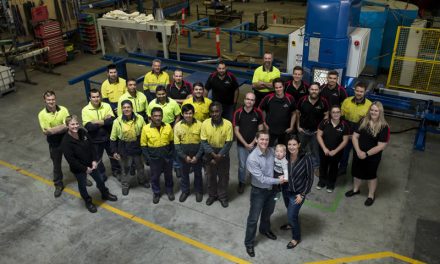Combilift has added the electric Combi-XLE to its range, delivering a five-tonne capacity, driver comfort, rugged capability and absolutely minuscule running costs.
Much is made of car fleets rapidly moving towards electrification around the developed world. It is a good change, but just as important is the electrification of working vehicles such as forklifts. Not only do electric models slash running and repair costs, they instantly improve work environments, removing both air and noise pollution for other workers.
Combilift has been leading the way in electric forklifts for nearly 20 years. The new Combi-XLE model is an impressive addition to the range. This multidirectional forklift with up to 5-tonne lift capacity, combines emission-free operation with powerful performance for a wide range of industries and applications, but particularly perfect for fabricators with its ability to lift wide and long loads and a multidirectional drive that aids it in moving long components or packages around a plant.
“The technology we have incorporated into the Combi-XLE means that its performance is on a par with diesel- or LPG-powered forklifts when it comes to handling very bulky and heavy loads, whilst of course offering a greener operation,” says Combilift CEO and co-founder Martin McVicar.
“We made our first electric C-Series over 18 years ago, and now over 60% of the trucks we manufacture are electric, with availability in almost all models across our range. As more and more of our customers are opting for electric power, it is obvious that they are as committed to sustainability and a circular economy as we are.”
And that’s not just marketing speak, the company has very much put its money where its mouth is, installing a lengthy list of eco-friendly features at its manufacturing facility in County Monaghan, Ireland. Solar panels are used for energy and rainwater harvesting helps conserve natural resources, while daylighting technology – LED lights with individual PIR sensors – decreases energy consumption. On the plant floor, 92% of all components used in truck assembly are 100% recyclable and the company is also on track to save over 430T of CO2 by using locally sourced carbon-neutral woodchip instead of gas for heating within the factory.
Hard worker
No one who’s been left at the lights by a Tesla is still pretending that electric vehicles bring any less power than their conventional cousins. But some (including a few fossil fuel aficionados in our federal parliament) continue to insist that only diesel can really deliver on the ‘grunt’ required by harsh Australian conditions. They’re wrong.
The original engine-powered XL C-Series model was developed to address the requirements of tough working environments such as those in the timber, concrete and steel sectors. The design principle back then was to develop versatile ‘3 forklifts in 1’ models, which could handle serious lifts both indoors and outside on unpaved surfaces, and also have the manoeuvrability to move through narrow racking. So businesses like fabricators and timber merchants would need only the one lifting truck to handle every job from unloading deliveries to picking up timber bundles from storage to loading finished frames and trusses for delivery.
The new Combi-XLE retains the same key design features as its ‘ancestor’, including high ground clearance, large, cushioned front and rear tyres and a spacious cab, allowing smooth operation on semi-rough terrain whilst offering a high level of driver comfort.
In addition, the electric model delivers significant noise pollution reduction. The product launch was accompanied by a video in which a David Attenborough impersonator listed the model’s features as one drove around a work site, lifting and moving wall frames, all the while with the sounds of local birdlife clearly audible over the vehicle’s movements. Noise has been shown to have negative impacts on the health and wellbeing of workers, as well as wildlife, and definitely affects the relationships between businesses and their neighbours in mixed-use areas. The electric models cut out the majority of noise pollution, improving work conditions for drivers and everyone else on or near site.
The one downside to running so silently is that electric vehicles can be riskier to other workers moving around them (in exactly the same way cyclists can be taken by surprise by electric cars). Combilift’s answer is very simple: add sound. “We’ve integrated new standard motion alarms on the electric vehicles,” says McVicar. “But rather than your standard loud beeping, these use new white noise technology, which adjusts the loudness of the alarm based on the ambient noise level. It’s enough so that you’ll hear it if you’re near the vehicle when it’s moving, but not enough to dominate the workspace and annoy everyone else.”
Even for businesses utterly unconcerned with reducing carbon emissions, the case for shifting to electrical operation is very strong. No exhaust fumes make the trucks better to work around and no combustion engines or hydraulic transmissions mean you can say goodbye to checking and topping up engine fluids and lubricants, resulting in longer intervals between services and ultimately saving costs.
The up-to-the-minute technology in the Combi-XLE incorporates patented all-wheel traction that reduces tyre wear and load swing and enhances braking, plus a newly developed, patented Eco-Steer System which provides a smaller turning radius and improved user experience. The use of toughened, eco-friendly water-based paint also dramatically reduces the amount of Volatile Organic Compounds (VOCs) generated during each unit’s build, which again benefits both the workforce and the environment.
The default unit battery is a standard rechargeable lead-acid battery. “We’ve left the system open,” says McVicar. “We didn’t want to dictate because some of our customers are already using lead-acid systems with their other machines and some using lithium, which can be easily fitted. At the moment, there’s better recyclability for lead acid, so we’ve stayed with that model.”
One of the first of the new trucks was delivered to UK firm piling and foundation engineering firm Roger Bullivant Ltd. “At our South Derbyshire precast factory, we use five multidirectional Combi-XLE trucks to transport product from the factory to storage and then to load-out for distribution nationwide,” says Dave Clament, product director at Roger Bullivant.
”As we had already been using Combi units for years, the product decision was straightforward, and from a driver perspective, the operation remains essentially unchanged. The reasons to move to electric were twofold: to eliminate exhaust particulates in the factory and as part of our Group environmental plan to minimise our carbon footprint. So, an improvement to the environment in more ways than one!”
At a glance
- AC electric powered
- 5T lift capacity
- 3 forklifts in 1 – counterbalance, side loader, reach truck
- Eco-Steer system
- All-wheel electric traction control
- Large diameter super elastic tyres
- Extra-large cabin
- Multidirectional operation
- Increased ground clearance
- 80V 700Ah Battery (56kW)
- 4040mm max lift height (C5000 XLE)
- 1T unladen weight (C5000 XLE)
- 2500mm minimum outside radius
For Australian enquiries, contact Chris Littlewood, Combilift’s county manager, via chris.littlewood@combilift.com
For more details and to see and (barely) hear the unit in use visit, www.combilift.com/xle
Image: Combi-XLE multidirectional electric forklifts include all-wheel traction, which increases outdoor safety, and the Eco-Steer system that delivers a smaller turning radius.












